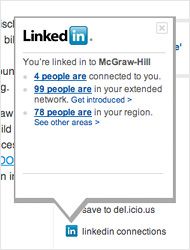
BusinessLinked If you’ve been to BusinessWeek.com lately, you may have noticed our article pages sporting some nifty new functionality. One of the first fruits of our partnership with LinkedIn, we’ve officially taken the wraps off the LinkedIn Company Insider tool.
Now a quick click inside our articles tells you if you’re connected to folks at companies in the news. Reading a BusinessWeek story about Ford’s effort to sell Jaguar? Click. Pop. Look, Ma! Turns out you’re connected to 8 people at Ford—through folks you already know on LinkedIn.

I’m jazzed about this not just because it showcases the mighty network effect of LinkedIn right where our users benefit the most from it, but also because it’s an article tool that’s gloriously contextual. The results you get spring directly from the specific news you’re reading.
Let’s face it, tons of news sites out there sport a box, zone, region or seeming jimjam somewhere on their articles that’s chock full of “article tools”. It’s pretty much obligatory. These are the links that “do something” with what you’re reading. But the options haven’t shown much in the way of new thinking for years—to say nothing of being truly compelling. A link to print. A link to e-mail. A link to share on the Web 2.0 flavor of the month. Zzzzzzzz…
It’s not that these items don’t serve a purpose. It just bothers me intensely that these tools typically don’t effect or interact with the content in terribly meaningful ways.
Well, consider this our little effort to shake off some of that dogmatic dust and get folks thinking about these tools again.
The tool itself is added via the DOM, which is worth noting for those of you out there that are (or aren’t yet) hip to Web Standards. When it came time to to do the deed and flip the big switch, all that was needed was a change to a single script file to add this feature to thousands of articles on BusinessWeek.com—past, present, and future. And by “thousands” I mean, “all of them.”
That’s huge. No Maalox moments charting CMS changes. No heinous text grinds. And no compromising on showing new features on some pages and not others. All this equals time and money saved (and made), in more ways than one. If you’re not clueful yet, do yourself a favor and spend a little quality time with folks that can help you out. If this exercise proves one thing, it’s that Web Standards are far more than a hobbyist’s pursuit—they’re a competitive business edge.
But that’s enough talk for now. Go check out the new tool and have some fun with your soon-to-be-expanding network!